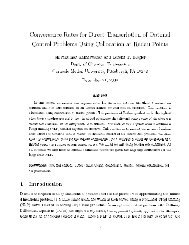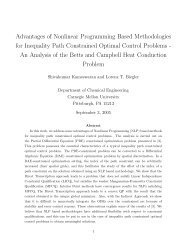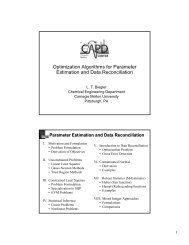MPEC Problem Formulations in Chemical Engineering Applications
MPEC Problem Formulations in Chemical Engineering Applications
MPEC Problem Formulations in Chemical Engineering Applications
You also want an ePaper? Increase the reach of your titles
YUMPU automatically turns print PDFs into web optimized ePapers that Google loves.
of the feed. The reflux ratio is allowed to vary between one and 20, the feedtraylocation varies between 2 and 20 and the total tray number varies between 3and 25. The objective function for the benzene-toluene separation m<strong>in</strong>imizes:objective = wt · D · x D,Toluene + wr · r + wn · Nt (50)where Nt is the number of trays, r is the reflux ratio, D is distillate flow,x D,Toluene is the toluene mole fraction and wt, wr, and wn are the weigh<strong>in</strong>gparameters for each term; these weights allow the optimization to trade offproduct purity, energy cost and capital cost. The benzene-toluene optimizationswere <strong>in</strong>itialized with 21 trays, a feedtray location at the seventh tray and areflux ratio at 2.2. Temperature and mole fraction profiles were <strong>in</strong>itialized withl<strong>in</strong>ear <strong>in</strong>terpolations based on the top and bottom product properties. Theresult<strong>in</strong>g GAMS models consisted of 353 equations and 359 variables for theReg(ǫ) and NCP formulations, and 305 equations and 361 variables for thePF(ρ) formulation. The follow<strong>in</strong>g cases were considered:• Case 1 (wt = 1, wr = 1, wn = 1): This represents the base case with equalweights on toluene <strong>in</strong> distillate, reflux ratio and tray count. As seen <strong>in</strong> theresults <strong>in</strong> Table 3, the optimal solution has an objective function value of9.4723 with <strong>in</strong>termediate values of r and Nt. This is found quickly by thePF(ρ) formulation. On the other hand, the Reg(ǫ) formulation term<strong>in</strong>atesclose to this solution, while the NCP formulation term<strong>in</strong>ates early withpoor progress.• Case 2 (wt = 1, wr = 0.1, wn = 1): In this case, less emphasis is given toenergy cost. As seen <strong>in</strong> the results <strong>in</strong> Table 3, the optimal solution nowhas a lower objective function value of 6.8103 along with a higher value ofr and lower value of Nt. This is found quickly by both PF(ρ) and Reg(ǫ),although only the former satisfies the convergence tolerance. On the otherhand, the NCP formulation aga<strong>in</strong> term<strong>in</strong>ates early with poor progress.• Case 3 (wt = 1, wr = 1, wn = 0.1): In contrast to Case 2, less emphasisis now given to capital cost. As seen <strong>in</strong> the results <strong>in</strong> Table 3, the optimalsolution now has an objective function value of 2.9048 with lowervalues of r and higher values of Nt. This is found quickly by the Reg(ǫ)formulation. Although Reg(ǫ) does not satisfy the convergence tolerance,the optimum could also be verified by PF(ρ). On the other hand, PF(ρ)quickly converges to a slightly different solution, which it identifies as a localoptimum, while the NCP formulation requires more time to term<strong>in</strong>atewith poor progress.Argon Column OptimizationThis argon separation column has a maximum of 63 trays, its feed is 6546.54lbmol/h of a 0.005%/9.753%/90.24% mixture of nitrogen/argon/oxygen anddistillate flow is specified to be 202.4576 lbmol/h with less than 1 mol % oxygen.24






